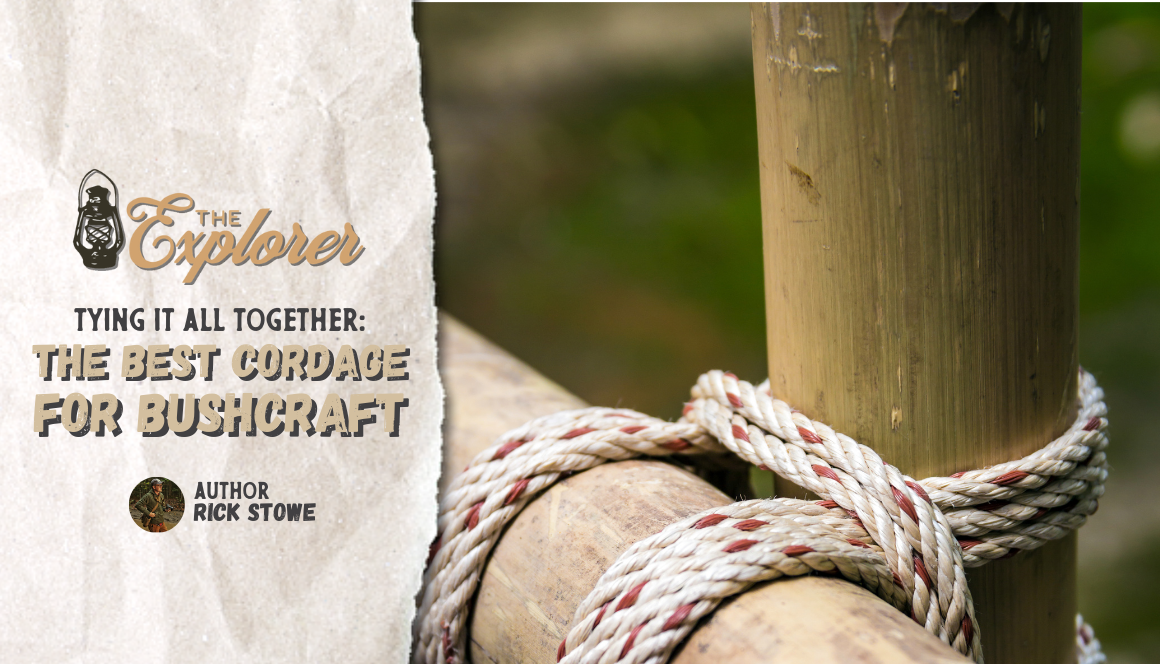
Tying It All Together: The Best Cordage for Bushcraft
When venturing into the great outdoors, having the right tools can make all the difference. While some might consider an axe, a knife, and a metal container the must-have items, it's important to remember to keep cordage on that list. Regardless of the variety, cordage serves a multitude of purposes, from crafting shelters to emergency repairs. While there are countless types of cordage available made of different materials and weight capacities, 550 cord/paracord, tarred bank line, and smaller diameter nylon accessory line tend to be the most common and popular.
 550 cord, aka paracord, is probably the most widely recognized in the bushcraft world, thanks in part to the popularity of the "survival bracelet." While these bracelets are a great way to keep a bit of paracord on you at all times, a larger bundle (aka a hank) can be used for everything from constructing a ridgeline to lashing a large shelter together.
550 cord, aka paracord, is probably the most widely recognized in the bushcraft world, thanks in part to the popularity of the "survival bracelet." While these bracelets are a great way to keep a bit of paracord on you at all times, a larger bundle (aka a hank) can be used for everything from constructing a ridgeline to lashing a large shelter together.
 Genuine MIL-SPEC Type III Paracord has seven inner cords, each made up of 3 strands, and some commercial grades are made up of slightly fewer inner strands, so double-check before loading the paracord with excessive weight. Like many things, there are cheaper varieties available, but they usually don't perform to the same standards as the top-of-the-line option. That being said, the cheaper paracord options will still hold a few poles together just fine, as long as proper lashing techniques are used.
Genuine MIL-SPEC Type III Paracord has seven inner cords, each made up of 3 strands, and some commercial grades are made up of slightly fewer inner strands, so double-check before loading the paracord with excessive weight. Like many things, there are cheaper varieties available, but they usually don't perform to the same standards as the top-of-the-line option. That being said, the cheaper paracord options will still hold a few poles together just fine, as long as proper lashing techniques are used.
 If you want take the capability of your paracord, take a look at some of the specialty varieties like Titan SurvivorCord and Parapocalypse Cord. They can the regular inner strands, plus specialty strands like brass wire, fire starter, fishing line, and more. This allows you to break down your cordage into smaller pieces that can be used for the task at hand.
If you want take the capability of your paracord, take a look at some of the specialty varieties like Titan SurvivorCord and Parapocalypse Cord. They can the regular inner strands, plus specialty strands like brass wire, fire starter, fishing line, and more. This allows you to break down your cordage into smaller pieces that can be used for the task at hand.
 Tarred bank line is another popular cordage option amongst the bushcraft crowd. It's highly water resistant, holds knots well, and much like 550 cord, it can be separated into smaller strands. Its tar coating not only ensures knot retention but also enhances durability, making it ideal for fishing lines, lashings, and shelter construction in wet conditions. Bank line, both tarred and un-tarred, is available in a number of weights. While not as strong as 550 cord, a good medium-weight bank line is #36, and it's rated to 325 lbs. Heavier and lighter-weight options are available to match a number of needs.
Tarred bank line is another popular cordage option amongst the bushcraft crowd. It's highly water resistant, holds knots well, and much like 550 cord, it can be separated into smaller strands. Its tar coating not only ensures knot retention but also enhances durability, making it ideal for fishing lines, lashings, and shelter construction in wet conditions. Bank line, both tarred and un-tarred, is available in a number of weights. While not as strong as 550 cord, a good medium-weight bank line is #36, and it's rated to 325 lbs. Heavier and lighter-weight options are available to match a number of needs.
 Smaller diameter cordage, like nylon accessory cord, offers a lightweight solution for delicate tasks in a compact package. It might take a lot of this type of cord to replace to paracord or bank line, but for securing gear, mending gear, or crafting improvised tools, its versatility complements the sturdier options. Plus, heavy-duty options constructed of kevlar and or high-strength synthetic fibers are surprisingly resilient and capable.
Smaller diameter cordage, like nylon accessory cord, offers a lightweight solution for delicate tasks in a compact package. It might take a lot of this type of cord to replace to paracord or bank line, but for securing gear, mending gear, or crafting improvised tools, its versatility complements the sturdier options. Plus, heavy-duty options constructed of kevlar and or high-strength synthetic fibers are surprisingly resilient and capable.
 In conclusion, having a variety of cordage at your disposal is a testament to your preparedness for outdoor adventures. From the classic 550 paracord to the water-resistant tarred bankline and the lightweight accessory cordage, each type has a unique role, ensuring you're ready for any survival scenario. So, before you set off on your next outdoor adventure, make sure to pack these essential cords – they could be your lifeline.
In conclusion, having a variety of cordage at your disposal is a testament to your preparedness for outdoor adventures. From the classic 550 paracord to the water-resistant tarred bankline and the lightweight accessory cordage, each type has a unique role, ensuring you're ready for any survival scenario. So, before you set off on your next outdoor adventure, make sure to pack these essential cords – they could be your lifeline.



